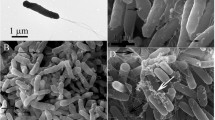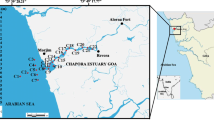Abstract
An ecological study ofVibrio parahaemolyticus was carried out from December 1970 to December 1971 in the Rhode River of Chesapeake Bay. The annual cycle of the organism was elucidated and factors restricting its distribution in the estuary were described, including the association of the organism with zooplankton. Numerical taxonomy was employed for identification and classification ofV. parahaemolyticus and related organisms on the basis of substrate utilization tests. From characteristics recorded forV. parahaemolyticus, it is concluded to be an estuarine organism.
Similar content being viewed by others
References
Aiso, K.: Survey of food poisoning outbreaks caused by pathogenic halophilic bacteria along the Chiba Prefecture coast. Shokuhin Eisei Kenkyu10, 21–25 (1960) (in Japanese)
Aiso, K., U. Shimidu, H. Katoh, K. Tatsumi, F. Sawada, and S. Katoh:Pseudomonas enteritis and related bacteria isolated from sea water in the Pacific coast area. Ann. Rept. Inst. Food. Micro., Chiba Univ.15, 12–20 (1963) (in Japanese)
Aoki, K.: Survey of the distribution ofVibrio parahaemolyticus in the Southwest Asia Sea In: T. Fujino and H. Fukumi (Eds.):Vibrio parahaemolyticus, Ed. 2, pp. 329–331. Nayashoten, Tokyo, Japan (1967) (in Japanese)
Aoki, K.: A survey of the distribution ofVibrio parahaemolyticus in the Middle Pacific Ocean. In: T. Fujino and H. Fukumi (Eds.):Vibrio parahemolyticus, Ed. 2, pp. 325–327. Nayashoten, Tokyo, Japan (1967) (in Japanese)
Asakawa, Y., S. Akabane, and M. Noguchi: Studies ofVibrio parahaemolyticus. 5. Distribution of the organism in Lake Hamana and overwintering experiments. Jap. J. Pub. Health13, 158 (1966)
Corner, E. D. S., and C. B. Cowey: Biochemical studies on the production of marine zooplankton. Biol. Rev.43, 393–426 (1968)
Darnell, R. M.: Organic detritus in relation to the estuarine ecosystem. In: G. H. Lauff (Ed.): Estuaries, pp. 376–382. American Association for the Advancement of Science, Publication No. 82, Washington, D.C. (1967)
Fishbein, M.: The aerogenic response ofEscherichia coli and strains ofAerobacter in EC broth and selected sugar broths at elevated temperatures. Appl. Microbiol.10, 79–85 (1962)
Heinle, D. R.: Production of a calanoid copepod,Acartia tonsa, in the Patuxent River estuary. Chesapeake Sci.7, 59–75 (1966)
Herman, S. S., J. A. Mihursky, and A. J. McErlean: Zopplankton and environmental characteristics of the Patuxent River estuary 1963–1965. Chesapeake Sci.9, 67–82 (1968)
Horie, S., K. Saheki, T. Kozima, and Y. Sekine: Oceanographic survey on the distribution of Takikawa's so-called pathogenic halophilic bacteria. Bull. Jpn. Soc. Sci. Fish.29, 37–43 (1963) (in Japanese)
Horie, S., K. Saheki, M. Nara, T. Kozima, Y. Sekine, and T. Takayanagi: Distribution of Takikawa's so-called pathogenic halophilic bacteria in the coastal sea area. Bull. Jpn. Soc. Sci. Fish.29, 785–793 (1963) (in Japanese)
Horie, S., K. Sakaki, T. Kozima, M. Nara, and Y. Sekine: Distribution ofVibrio parahaemolyticus in plankton and fish in the open sea. Bull. Jpn. Soc. Sci. Fish.30. 786–791 (1964) (in Japanese)
Horie, S., K. Sakeki, and T. Okuzami: Quantitative enumeration ofVibrio parahaemolyticus in sea and estuarine waters. Bull. Jpn. Soc. Sci. Fish.33, 126–130 (1967) (in Japanese)
Kaneko, T.: Ecology ofVibrio parahaemolyticus and related organisms in Chesapeake Bay. Ph.D. thesis, Georgetown University, Washington, D.C. (1973)
Kaneko, T., and R. R. Colwell: Ecology ofVibrio parahaemolyticus in Chesapeake Bay. J. Bacteriol.113, 24–32 (1973)
Kaneko, T., and R. R. Colwell: Distribution ofVibrio parahaemolyticus and related organisms in the Atlantic Ocean off South Carolina and Georgia. Appl. Microbiol.28, 1009–1017 (1974)
Kaneko, T., and R. R. Colwell: Adsorption ofVibrio parahaemolyticus onto chitin and copepods. Appl. Microbiol.29, 269–274 (1975)
Kaneko, T., and R. R. Colwell: Incidence ofVibrio parahaemolyticus in Chesapeake Bay. Appl. Microbioi.30, 251–257 (1975)
Lederberg, J., and E. M. Lederberg: Replica plating and indirect selection of bacterial mutants. J. Bacteriol.63, 399–406 (1952)
Lee, J. S.: Inactivation ofVibrio parahaemolyticus in distilled water. Appl. Microbiol.33, 166–167 (1972)
Miyamoto, Y.: Oceanographic survey and halophilic bacteria. Shokuhin Eisei Kenhyu.119, 23–30 (1960) (in Japanese)
Morita, R. Y., and R. D. Haight: Temperature effects on the growth of an obligate psychophilic marine bacterium. Limnol, Oceanogr..9, 103–106 (1964)
Nishio, T.: An ecological study ofVibrio parahaemolyticus. 3. A comparison of the K-antigens and haemolysis of strains isolated from the marine environment and from patients. Jpn. J. Bacteriol.22, 447 (1967) (in Japanese)
Noguchi, M., and Y. Asakawa: Distribution ofVibrio parahaemolyticus. In: T. Fujino and H. Fukumi (Eds.):Vibrio parahaemolyticus, Ed. 2, pp. 313–323. Nayashoten, Tokyo, Japan (1967) (in Japanese)
Ose, Y., and T. Ikeda: Studies onVibrio parahaemolyticus from night soil. Isolation ofV. parahaemolyticus from night soil. Shukuhin Eiseigaku Zasshi.5, 206–210 (1964) (in Japanese)
Oshiro, T.: The distribution of Vibrio parahaemolyticus in nature. In: T. Fujino and H. Fukumi (Eds.):Vibrio parahaemolyticus, Ed. 1, pp. 263–277. Isseido, Tokyo, Japan (1964) (in Japanese)
Sakai, S., T. Terayama, Y. Kudoh, and H. Zen-Yoji: A study of the pathogenic halophilic bacteria. VI. A survey of the marine and terrestrial environment. Jpn. J. Bacteriol.18, 253 (1963) (in Japanese)
Sakazaki, R.:Vibrio parahaemolyticus and related organisms—a taxonomic study. In: T. Fujino and H. Fukumi (Eds.):Vibrio parahaemolyticus, Ed. 2, pp. 83–115. Nayashoten, Tokyo, Japan (1967) (in Japanese)
Sato, M., and H. Takahashi: Cold shock of bacteria. II. Magnesium-mediated recovery from cold shock and existence of two critical temperature zones in various bacteria. J. Gen. Appl. Microbiol.15, 217–229 (1969)
Sokal, R. R., and P. H. A. Sneath: Principles of Numerical Taxonomy. W. H. Freeman and Co., San Francisco (1963)
Staley, T. E., and R. R. Colwell: Polynucleotide sequence relationship among Japanese and American strains ofVibrio parahaemolyticus. J. Bacteriol.114, 916–927 (1973)
Stanier, R. Y., N. J. Palleroni, and M. Doudoroff: The aerobic pseudomonads: A taxonomic study. J. Gen. Microbiol.43, 159–271 (1966)
Strickland, J. D. H., and T. R. Parsons: A Manual of Sea Water Analysis, Ed. 2. Fisheries Research Board of Canada, Ottawa, Canada (1965)
Takikawa, I.: Certain halophilic bacteria isolated from food poisoning patients. Jpn. J. Infect. Dis.30, 439–500 (1956) (in Japanese)
Tenmei, R., and F. Yanagisawa: Studies of the resistance of the pathogenic halophilic bacteria to cold temperatures. Nippon Kohshu Eisei Zasshi9, 447 (1962) (in Japanese)
Terayama, T.: Studies of the pathogenicity ofVibrio parahaemolyticus. II. Ecological survey and pathogenicity of isolates from various sources. Jpn. J. Bacteriol.20, 162–167 (1965) (in Japanese)
Wagatsuma, S., K. Tanji, K. Yuda, T. Shiratori, J. Konno, T. Watanabe, H. Monma, K. Hirama, K. Hayasaka, and M. Shimizu: Food poisoning caused by ingestion of raw oysters contaminated byVibrio parahaemolyticus and survey of the source. Media Circle16, 168–171 (1971) (in Japanese)
Yanagisawa, F., Y. Tanaka, S. Hirose, and M. Yamaguchi: Studies of halophilic bacteria. XII. Halophilic chitinoclastic bacteria and the causative agent of food poisoning. Nippon Eiseigaku Zasshi15, 27 (1960) (in Japanese)
Yasunaga, N.: Studies of pathogenic halophilic bacteria. I. Pathogenic halophilic bacteria isolated from the river in Nagasaki city. Shokuhin Eisei Kenkyu5, 112–115 (1964) (in Japanese)
Yasunaga, N., and M. Kuroda: Studies ofVibrio parahaemolyticus. II. Distribution ofVibrio parahaemolyticus in marine sediment and on fish in Southeast Asia. Endemic Dis. Bull. Nagasaki Univ.6, 201–208 (1964)
Zen-Yoji, H. S., S. Sakai, Y. Kudo, T. Terayama, and T. Itoh: Study of pathogenic halophilic bacteria. VII. An ecological survey and examination of the relationship between biotypes and causative strains. Jpn. J. Bacteriol.18, 477–478 (1963) (in Japanese)
ZoBell, C. E.: The effect of solid surfaces upon bacterial activity. J. Bacteriol.46, 39–56 (1973)
Author information
Authors and Affiliations
Rights and permissions
About this article
Cite this article
Kaneko, T., Colwell, R.R. The annual cycle ofVibrio Parahaemolyticus in chesapeake bay. Microb Ecol 4, 135–155 (1977). https://doi.org/10.1007/BF02014284
Issue Date:
DOI: https://doi.org/10.1007/BF02014284




